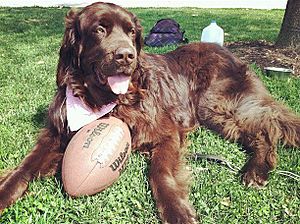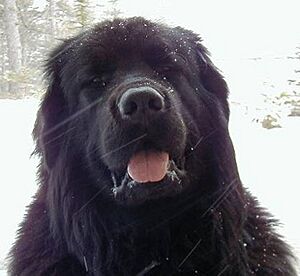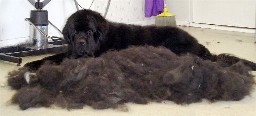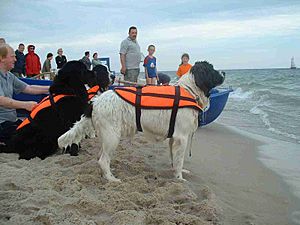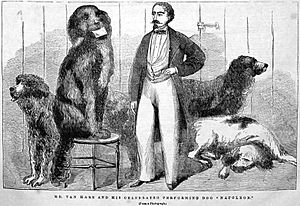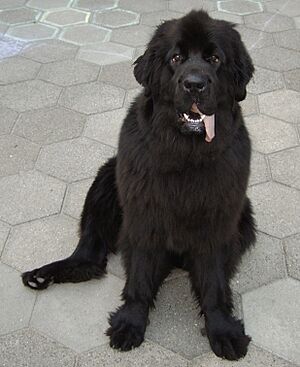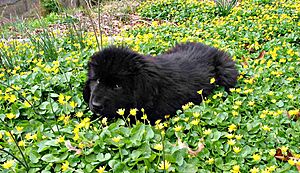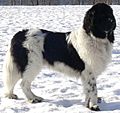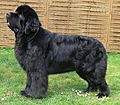Newfoundland (dog) facts for kids
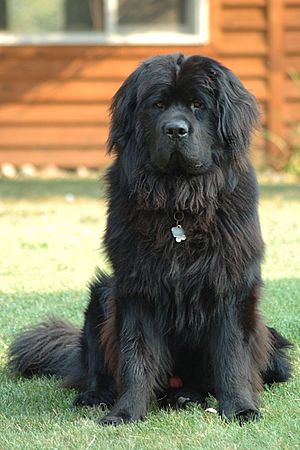 |
|||||||||||||||||||||||||||||||||
| Origin | Newfoundland and Labrador, Canada | ||||||||||||||||||||||||||||||||
|---|---|---|---|---|---|---|---|---|---|---|---|---|---|---|---|---|---|---|---|---|---|---|---|---|---|---|---|---|---|---|---|---|---|
|
|||||||||||||||||||||||||||||||||
|
|||||||||||||||||||||||||||||||||
| Notes | Provincial mammal of Newfoundland | ||||||||||||||||||||||||||||||||
| Domestic dog (Canis lupus familiaris) | |||||||||||||||||||||||||||||||||
The Newfoundland dog is a very large working dog. These dogs are often called "Newfs" or "Newfies." They can be black, brown, or white with black patches. The white and black dogs are known as Landseers. In Canada, where they first came from, only black or Landseer colors are considered correct.
Newfoundland dogs were first used by fishermen in Newfoundland. This area is now part of Canada. They helped fishermen with many tasks. These dogs are known for their huge size and smart minds. They are also very strong, calm, and loyal. Newfoundlands are excellent at water rescue and lifesaving. This is because they are very strong and have a thick, waterproof coat. They also have webbed feet and are natural swimmers.
Contents
About Newfoundland Dogs
What They Look Like
Newfoundland dogs have special features for water. They have webbed feet, like a duck's. Their fur is also water-resistant. Male Newfoundlands usually weigh between 65–80 kg (143–176 lb). Females weigh 55–65 kg (121–143 lb). This makes them "Giant" dogs. Some Newfoundlands have weighed over 90 kg (200 lb). The biggest one ever recorded weighed 120 kg (260 lb). It was also over 1.8 m (6 ft) long from nose to tail. They can grow up to 56–76 cm (22–30 in) tall at the shoulder.
The American Kennel Club (AKC) says Newfoundland dogs can be black, brown, gray, or white-and-black. The white-and-black pattern is called Landseer. Other colors exist but are not special. The The Kennel Club (KC) in the UK allows only black, brown, and white/black. The Canadian Kennel Club (CKC) only allows black and white/black. The "Landseer" pattern is named after an artist. Sir Edwin Henry Landseer painted many dogs with these markings. The Fédération Cynologique Internationale (FCI) sees the ECT Landseer as a different breed. This dog is taller and thinner. It is white with black markings.
Newfoundlands have very large bones. This gives them their mass. Their strong muscles help them handle rough ocean waves. These dogs have huge lungs. This lets them swim very long distances. Their thick, oily, and waterproof double coat keeps them warm in cold water. This double coat needs a lot of grooming. It also causes them to shed a lot of fur. Their droopy lips and jowls mean they drool, especially when it's hot.
In the water, their big webbed paws help them move fast. They don't swim like other dogs. Newfoundlands move their legs in a special "down-and-out" way. This gives them more power with each stroke.
Their Personality
Newfoundland dogs are known for being calm and gentle. They are also very strong. They are extremely loyal. This makes them great working dogs. Because of this, they are often called "the gentle giant." Dog clubs around the world say they have a sweet personality. They usually have a deep bark. They are easy to train if you start when they are young. They are wonderful with children. However, their large size means they might accidentally lean on or knock over small kids. Newfoundlands are perfect for therapy work. They are sometimes called "nanny dogs." A famous Newfoundland, "Nana," was the guardian dog in J.M. Barrie's Peter Pan. Newfoundlands usually get along well with other animals. But their size means they need good training.
A Newfoundland's sweet nature is so important. It is even written in the Breed Standards for many countries. Dogs that are aggressive are not allowed in shows. They should also not be used for breeding. The breed standard in the United States says: "Sweetness of temperament is the hallmark of the Newfoundland; this is the most important single characteristic of the breed."
Where They Came From
Newfoundland dogs share traits with other large dogs. These include the St. Bernard and English Mastiff. They have strong legs, big heads, and thick necks. Many St. Bernard dogs have Newfoundland ancestors. Newfoundlands were used to help the St. Bernard breed in the 1700s. This was when a disease threatened the St. Bernard population. Newfoundlands also share traits with mountain dog breeds like the Great Pyrenees.
The Newfoundland breed started on the island of Newfoundland. They came from a local dog called the lesser Newfoundland, or St. John's dog. DNA tests show Newfoundlands are related to other Canadian retrievers. These include the Labrador, Nova Scotia Duck Tolling Retriever, and Golden Retrievers. The Newfoundland's large, strong look might come from Portuguese Mastiffs. Portuguese fishermen brought these dogs to the island in the 1500s.
By 1610, when people were allowed to settle in Newfoundland, the breed's traits were set. In the early 1880s, fishermen from Ireland and England came to Newfoundland. They saw two main types of working dogs. One was large and heavily built with long fur. This was the Greater Newfoundland, or Newfoundland. The other was medium-sized with smooth fur. This was the Lesser Newfoundland, or St. John's dog. The St. John's dog became the ancestor of modern retrievers. Both types of dogs helped pull fishing nets. The Greater Newfoundland also pulled carts and other gear.
Newfoundlands also helped create other breeds. They were part of the foundation for the Leonberger. The Canadian government even imported Leonbergers for water rescue.
Many stories tell of the bravery of Newfoundlands. They have been heroes in adventures and rescues. Over the last two centuries, artists have shown these dogs in paintings and sculptures. One famous Newfoundland was a dog named Seaman. He traveled with American explorers Lewis and Clark on their journey.
Newfoundlands had many different jobs. A famous black Newfoundland was a star in Van Hare's Magic Circus in England, starting in 1862. This dog was called "Napoleon the Wonder Dog." He was very popular. Napoleon could spell his name with letters. He could also play cards and jump over horses. He even danced to music!
Napoleon the Wonder Dog became very famous in London. Sadly, he died at 11 years old after a circus accident. His death was even announced in newspapers. The Sheffield Daily Telegraph called him "The Wizard Dog." They said he was a "noble specimen of the Newfoundland breed."
The breed did well in the United Kingdom. But their numbers dropped a lot during World War I and World War II. This was because of wartime rules. Since the 1950s, their numbers and popularity have grown. Even though they are large and love mud and water, many people enjoy having them as pets.
Amazing Rescues
Newfoundlands are known for saving people from water. On the Discovery Channel, it was reported that one Newfoundland helped rescue 63 sailors from a shipwreck. Today, dog clubs in the United States hold Newfoundland Rescue Demonstrations. They also offer classes in water rescue. Many boat tours in St. John's have a Newfoundland on board. This is for charm and for passenger safety.
- An unnamed Newfoundland is said to have saved Napoleon Bonaparte in 1815. Napoleon fell overboard during his escape from Elba. A fisherman's dog jumped in and kept Napoleon afloat until he was safe.
- In 1828, Ann Harvey and her family, along with a Newfoundland named Hairyman, saved over 160 Irish immigrants. They were from a shipwreck called the Despatch.
- In 1881, in Melbourne, Australia, a Newfoundland named Nelson helped save a cab driver. The driver was swept away by flood waters. Nelson's copper dog collar is now in the National Museum of Australia.
- In the early 1900s, a dog believed to be a Newfoundland saved 92 people from the SS Ethie. The ship was wrecked during a blizzard off Newfoundland. The dog brought a rope from the ship to shore. Everyone on board was saved, even a baby in a mailbag. You can still see parts of the ship in Gros Morne National Park.
- In 1995, a 10-month-old Newfoundland named Boo saved a man from drowning. The man, who was hearing-impaired, fell into the Yuba River in California. Boo saw him struggling and pulled him to safety. Boo had no special training for water rescue.
Newfoundlands continue to work as rescue dogs today. Other breeds like the Leonberger, Labrador Retriever, and Golden Retriever also do this important job.
Images for kids
-
The classic "Landseer" markings. This painting is by Sir Edwin Henry Landseer: Lion: A Newfoundland Dog, 1824.
-
A Landseer dog.
See also
 In Spanish: Terranova (perro) para niños
In Spanish: Terranova (perro) para niños


